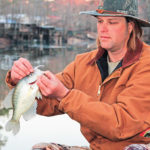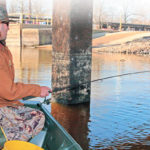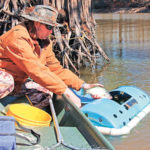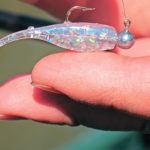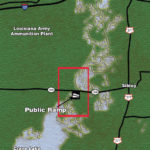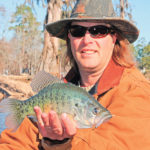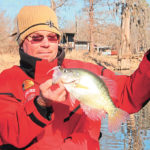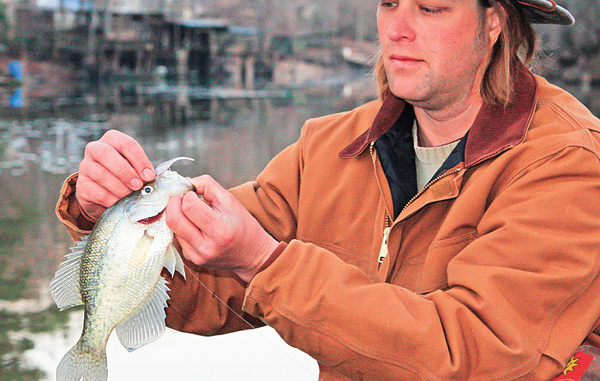
This angler follows the fantastic crappie bite from Bayou Dorcheat into Lake Bistineau.
The ice on the surface of the water of Wesley Miller’s minnow bucket wasn’t exactly a harbinger of things to come, but it was a sign of just how cold it was at the start of our fishing trip.
I think the cold was more of a discomfort for me than it was Miller. In fact, he had tried to get me up to North Louisiana the weekend before when snow and ice covered roads and bridges in that part of the state.
Miller adamantly let me know that if I wanted our trip to Bayou Dorcheat to produce white perch, I had better come before the water temperature crept up toward the upper 50s. At that temperature, white perch leave the bayou en masse and head north to the barrow pits around I-20 or south to Lake Bistineau to spawn.
As it was this day, the water temperature wasn’t even close.
Before I had cracked the ice in the minnow bucket, I had noticed that the water seemed awfully low. Miller’s aluminum johnboat was beached on a little patch of sand at the base of a concrete seawall right out the front door of his house. The water was so low that we had to take a small trail down the side of the seawall to reach the boat below.
Bayou Dorcheat feeds into Lake Bistineau, which had been drawn down in an effort to deal with the lake’s giant salvinia problem. Apparently, the water from the bayou was getting sucked right down with the lake.
Miller, a nurse at a small rehab facility in Shreveport called Promise Hospital, works 12-hour night shifts. When get gets back to his house on Bayou Dorcheat each morning, he jumps in his boat to fish for an hour before going to bed.
“That’s the time I give myself to fish,” he said. “Whether I’ve caught anything or not, I’ve got to get home and get to bed so I can go to work later.
“Other than that, I’m out here every weekend, every day, usually all day long.”
Miller comes from a fishing family. His parents never took a vacation that they didn’t take their kids, and they never took a vacation that they didn’t fish. His family still fishes together quite regularly, and they particularly enjoy wade fishing Holly Beach below Calcasieu Lake.
He recently ventured into the world of tournament bass fishing. In fact, on the day before our trip, I called to confirm the details only to find that Miller had come straight home from a tournament at Black Lake and got in his johnboat for a little white perch fishing.
And there wasn’t a time I texted or called him before that when he wasn’t on the water trying to catch a few white perch.
“When it comes down to it,” he admitted, “there’s not much more I would rather be doing than perch jerking.”
Perch jerking was precisely what we had on our minds as Miller piloted his boat downstream in Bayou Dorcheat. Because I haven’t been in a johnboat in a long time, my legs felt like Jell-O as we maneuvered around each other at our first stop — Miller to the front and me to the back.
He grabbed a small sculling paddle and threw a wake behind his boat as he maneuvered it into position for us to fish the first tree top that had fallen over a bluff bank and into Bayou Dorcheat. By 6:50 on this frosty morning, he swung our first white perch in the boat.
“Never felt him hit,” Miller said while unhooking his fish. “All I saw was my line curl up. And he was only 2 or 3 feet deep sitting in this top over 9 feet of water. That’s a good tip for fishing these tops. Rather than letting your bait free fall into the structure, lower it slowly with your rod tip. If your line curls up before you think it’s hit bottom, you’ve either got a limb or a fish. Pull up and you’ll know for sure.”
Just 10 minutes later, Miller swung a barfish into the boat. Although they aren’t his target fish, Miller says they get mixed in with the white perch a little bit during later winter as they run up the creek from Lake Bistineau to spawn. And a huge population of white bass can be caught on crawfish, crankbaits and jigs.
Barfish and white bass weren’t what we were after, though, so we made a small move to try to get in a pile of white perch. By 7:03, we were in them again without having to ever switch seats.
Thankfully, my hand had spent many hours wrapped around the handle of a tiller-steer motor during my upbringing on the banks of the Bogue Chitto River, and Miller trusted me enough to drive from here on out.
“I felt that bite,” Miller said as he released our second white perch into his fish basket. “And this one was a lot deeper than the first one.
“I’m fishing an opening night-colored Bobby Garland Baby Shad rigged on a 1/32-ounce jig, and I’ve got it tied to 6-pound-test fluorocarbon line.”
Miller prefers the opening night color because he believes it looks more natural in the water than some of the hot colors that tube jigs are known for. In fact, he picked out a minnow from the bucket and held it up against his jig. When the minnow caught the sun just right, its coloration was almost exactly that of the opening night jig.
And although he admittedly loses a few jigs because of his 6-pound line, Miller says he would rather give up a few jigs for the few extra bites he believes he gets by fishing such a small diameter line.
“And the fluorocarbon lets me feel the bites better because it doesn’t have much stretch,” Miller added. “It’s way more sensitive than mono because of that, and this 6-pound line helps me keep my 1/32-ounce jig, line and rod tip all in one straight line.
“That makes it a lot easier to get my jig in and out of the structure, which gives me more control of my bait and a better idea of my depth.”
Our third and fourth white perch came at 7:08 and 7:10 respectively. We noticed that the fish had kind of a yellow tint to them, and Miller thought it might have something to do with either the water being a little stained or so cold.
Miller decided that the action wasn’t fast enough, so he scooped a minnow out of the bucket and tipped his jig with it by threading the hook through the minnow’s lips. Strangely enough, he missed his next four or five bites.
He initially thought it might have been because it was small fish, but Miller then thought he might not have been giving the white perch enough time to get the entire jig-and-minnow package in their mouths.
“I may not be letting them take it good enough,” he said. “I didn’t miss any bites until I tipped with the minnow.
“It’s a little more for them to eat. Maybe I’ll start giving them a second or two longer once I feel the first thump. Let’s see if that will work.”
By 8:13 when we landed our sixth fish of the morning, Miller assessed our bite. He rated it as kind of slow because he would usually have 10 or 12 fish by this time of the morning. He wasn’t sure if the color of the water had anything to do with it or if we could chalk it up to that just being fishing.
We moved around a few more times and eventually wound up fishing a submerged stump that Miller said used to have a small stick marking it. The stick was missing, so we had to circle the area while dragging our jigs in an effort to find the stump.
“A stump like this is a little bit different than the tree tops,” Miller explained. “They suspend in the limbs of a top, but they hold as tight as they can get to a stump like this.
“I would imagine they’re sitting down there with their noses right on the edge of the stump, and we’re going to have to drop our baits right on the edge of the stump to get a bite.”
His technique worked perfectly as I first felt our hidden target. I lifted the jig and let it fall off the top of the stump when our biggest white perch of the day inhaled it. Having discovered the stump’s location, Miller hung out and milked it for all it was worth.
Our best effort on this bitter morning was 12 white perch. Miller tagged our day at the low end of an average day. He generally catches somewhere around 20 to 25 fish on a typical weekend morning, but we finally decided that a dozen fish wasn’t such a bad day, especially since most everybody else around us was struggling to get a single bite.
By paying attention to the minor details, Miller was able to put us on enough fish to make for a fine meal. Paying attention to the small factors like how deep our bites were, how close to the structure our jigs were, whether we were holding our jigs still or moving them made a big difference.
Even though the bite was slow, Miller felt right at home doing what he loves most — jerking on some Bayou Dorcheat white perch. It’s all the rehab he needs.
